Column: Can AI dream up a more sustainable Los Angeles?
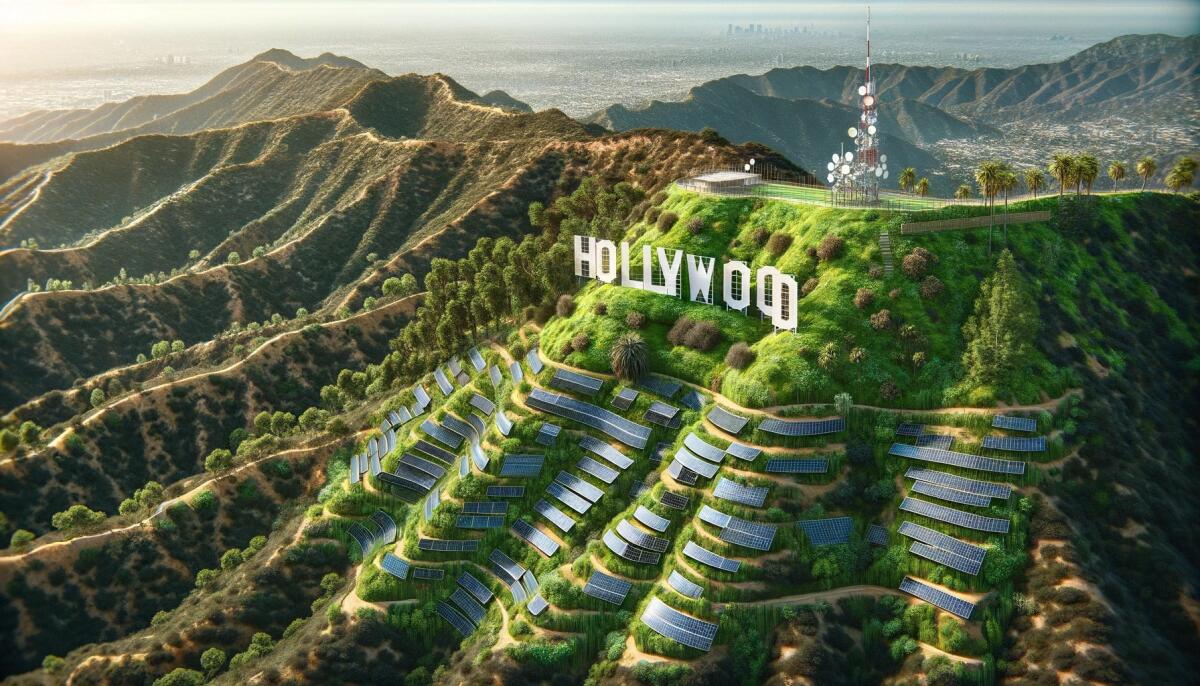
- Share via
“Tell them stories. They need the truth. You must tell them true stories, and everything will be well.”
So says the ghost of an old woman to nun-turned-astrophysicist Mary Malone in “The Amber Spyglass,” the final tome in Philip Pullman’s “His Dark Materials” trilogy and one of my favorite novels. The admonition came to mind as I explored an unusual art exhibit at USC’s Wrigley Marine Science Center on Catalina Island, two dozen miles off the Southern California coast.
A series of 11 images envisions a sustainable future for Los Angeles — as dreamed up by artificial intelligence.
You're reading Boiling Point
Sammy Roth gets you up to speed on climate change, energy and the environment. Sign up to get it in your inbox twice a week.
You may occasionally receive promotional content from the Los Angeles Times.
One image shows a downtown streetscape, shaded by overhead walkways teeming with vegetation. Another adds solar panels to the hillsides beneath the Hollywood sign. Several contemplate vibrant futures for the L.A. River, tearing out concrete flood-control straitjackets along its banks and reviving the waterway with abundant plants and wildlife, as well as walking paths.
One especially mind-bending picture replaces cars with bicycles on a freeway along the river.

Are any of these visions realistic? Does it matter if they could ever be “true”?
And how should we feel about the fact that shadowy computer brains played a role in creating them?
I posed those questions to Allison Agsten, the art curator at USC’s Wrigley Institute for Environment and Sustainability. She also leads the Center for Climate Journalism and Communication at USC’s Annenberg School for Communication and Journalism, and she oversaw development of the sustainable L.A. exhibit. She has mixed feelings about artificial intelligence herself.
“This installation represents an experiment,” Agsten said.
And not always a smooth one, she was quick to acknowledge.
Catalina Island has been beset by invasive mule deer, which were introduced by humans in the 1930s for hunting. According to the Catalina Island Conservancy, the nonnative deer destroy natural habitats, increasing fire risk and harming native animals.
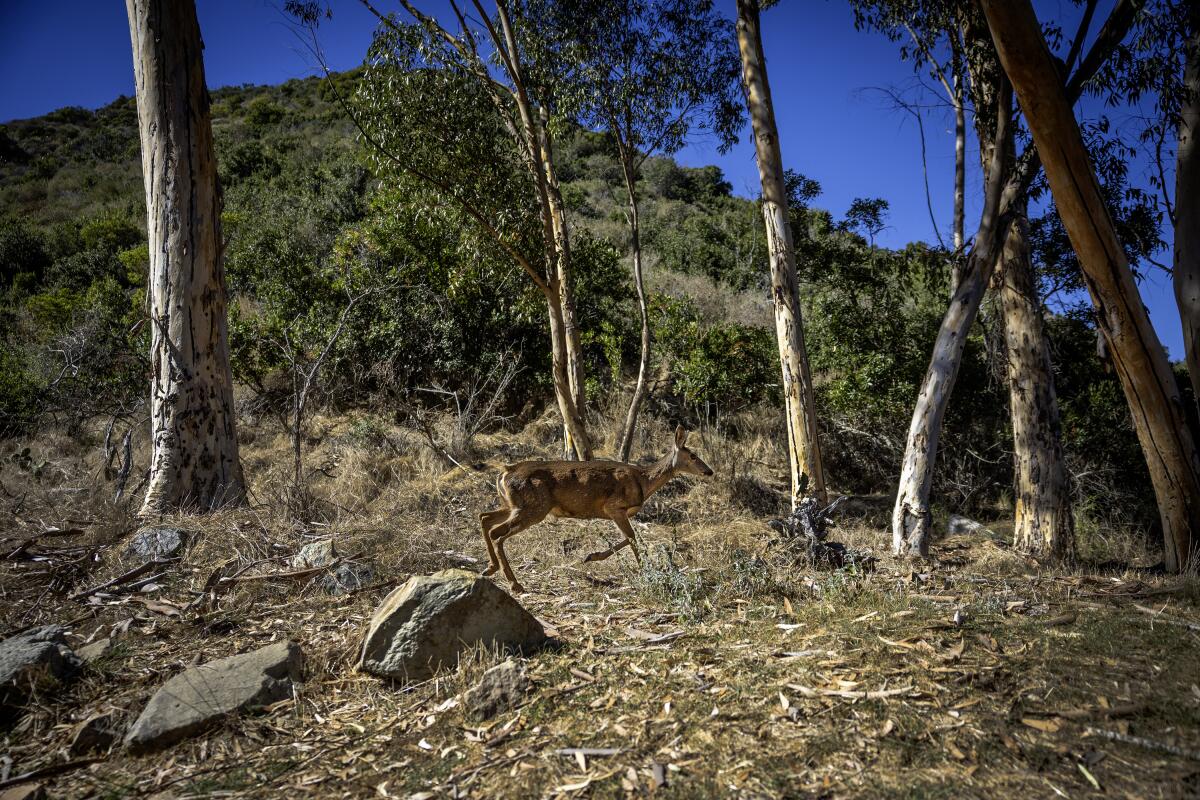
But when USC cinematic arts professor Kathy Smith and three grad students asked their AI programs, which included Midjourney and OpenAI’s Dall-E, to dream up a sustainable Catalina, one of the programs created an image of “a flourishing deer population,” Agsten recalled — seemingly tricked by all the online discussion into thinking that more deer would be good, not terrible.
“I said [to the students], let’s talk about why that image isn’t going to work,” Agsten told me.
The invasive mule deer didn’t make the exhibit. Neither did various other digital fever dreams, from some that Agsten described as “dark and apocalyptic” to others that she called “some of our absolutely most radical depictions” of a future Los Angeles.
I know just enough about artificial intelligence to be worried — but not enough to know how worried I should be.
In the hands of Google and Meta, the technology threatens the news business, by taking journalism produced by people like me and handing it out for free (after occasionally mangling it to the point where it’s no longer accurate). The data centers that power AI consume huge amounts of energy and water. Also bad: Liars can use AI to create images that distort reality for nefarious ends, such as tricking people into thinking that national parks have been overrun by migrant tent camps. (They have not.)
So why turn to potentially dystopian tech to envision a better future? Why not let Smith and her students flex their creativity?
Agsten had a practical answer: Artificial intelligence can save a heck of a lot of time.

Instead of spending months debating ideas, drafting designs and deciding which ones merited further development, Smith and her students were able plug prompts into ChatGPT and and let the machines quickly spit out options. They produced and sorted through about a hundred potential images, using the initial AI creations to hone their instructions to the computer brains.
The part that took the longest — and required the most creativity — was coming up with the right prompts.
“In real life, I would never do that. I would never tell the artist what to make,” Agsten said.
The neural networks came up with stuff that humans might not have — at least not so quickly. Some of it was nonsense, like the invasive deer. But other fantasies were more intriguing. Agsten especially enjoyed an AI-generated image of a cargo ship covered with verdant trees and other greenery — an unusual rethinking of Southern California’s highly polluting shipping industry.
“Something different happens in the mind when you create something that defies even your own expectations or ideas,” Agsten said. “I don’t think anybody who plugs in the prompts for this ship necessarily imagined that this was going to come up.”
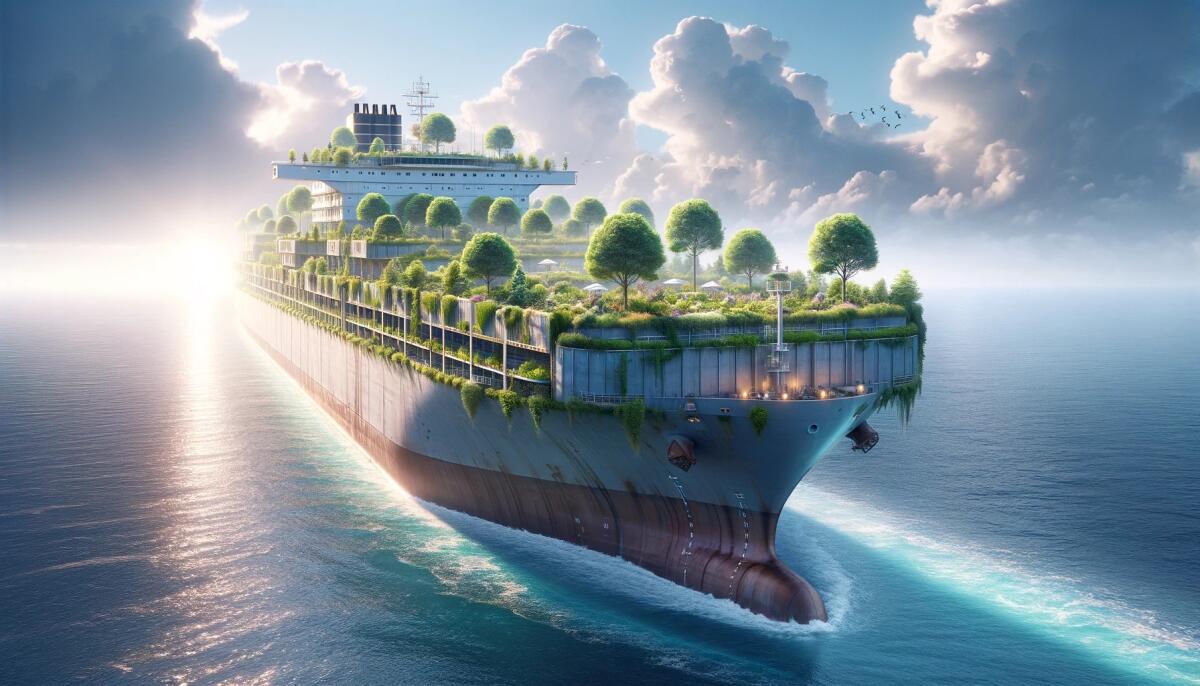
For me, taking in the AI-generated images was a strange, fascinating experience.
I am the furthest thing from an art critic. Unless you consider Disneyland to be a work of art, which, let’s be real, I do.
But enjoying the pleasant summer breeze on Catalina, with a small mountain rising behind the art, I found myself reflecting on my home city — everything I love about Los Angeles, and everything that should be better about it. The good weather, the great hiking, the amazing food and entertainment. The terrible traffic, the polluted air, the lack of parks in many neighborhoods.
The fantastical AI artwork was doing its job. It was expanding my consciousness, making me reconsider what L.A. could be.
“Once you’re in a museum gallery, you could be in Kansas City. You could be in Corsica. You could be anywhere,” Agsten said. “I am really curious how people experience this differently than they would if it was on a wall at the main campus at USC.”
The whole Wrigley Marine Science Center felt a world away from USC’s home base in Exposition Park.
I got there via boat, a diesel-fueled vessel called the Miss Christi that Wrigley officials are looking to raise money to replace before it falls out of compliance with state pollution rules. The island campus itself was more sustainable, with a solar array on the dining hall and plans for a solar-plus-battery microgrid — a big deal on an island currently powered mostly by diesel generators.
“At least 95% of our operations will be powered by the solar grid,” said Sean Conner, associate director of operations.
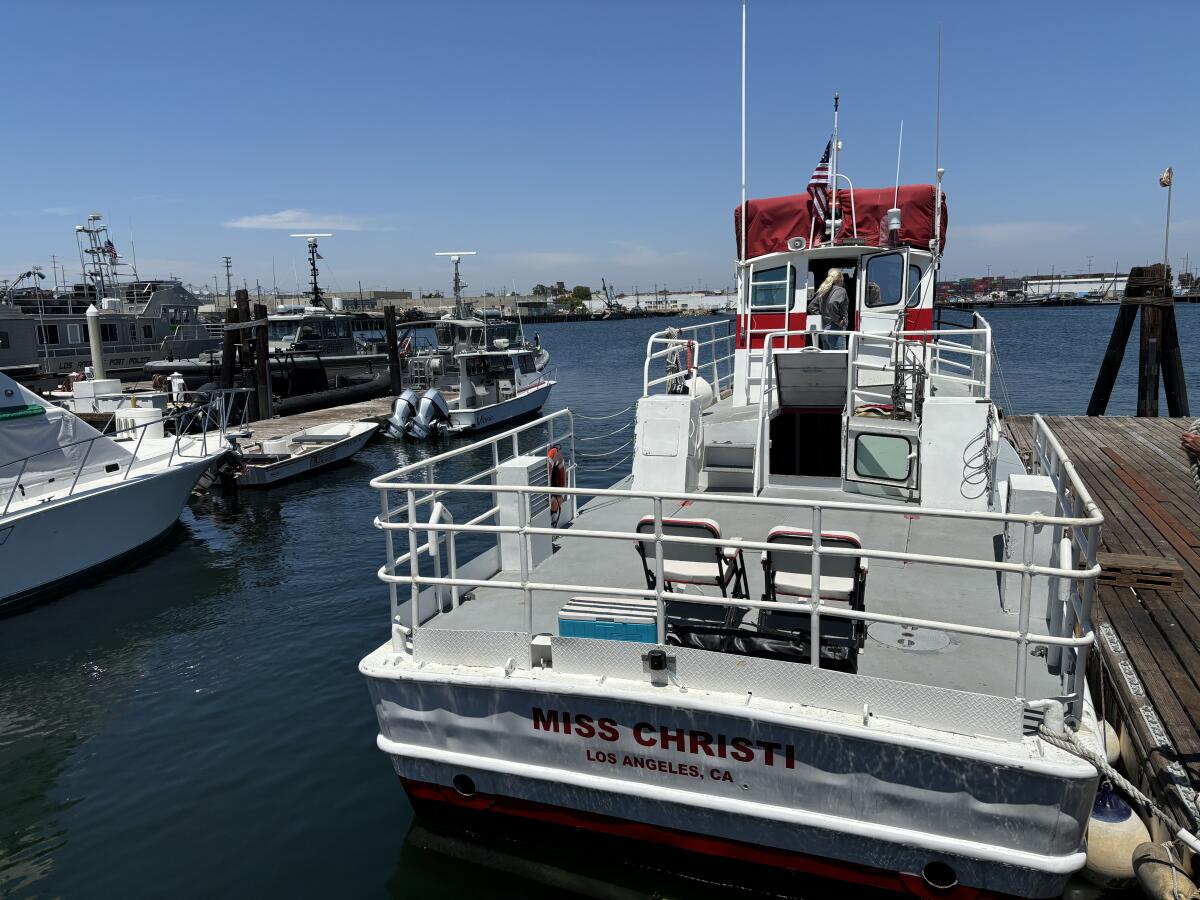
As Conner and his colleagues showed me around the campus, they told me about its history. Chewing gum magnate and Chicago Cubs owner William Wrigley Jr. bought most of Catalina Island for $2 million in 1916. Nearly half a century later, his conservationist son Philip, who helped found the Catalina Island Conservancy, gifted some of the land to USC for a marine science station.
Eleven miles as the crow flies from Avalon, the island’s main town, professors train students and do their own research. Current focus areas include protecting Catalina Island foxes — cute critters, despite how much they annoyed me as they skittered into my campsite outside Avalon that evening — and capturing heat-trapping carbon emissions from cargo ships. The latter initiative has received funding from the Ballmer Group, which was co-founded by former Microsoft chief executive and Clippers owner Steve Ballmer.
Another cool project involves using sunflowers to mine nickel — a key metal for the clean energy transition.
Researchers will plant hundreds of varieties of sunflowers in the science center’s greenhouse, in soil containing the metal. They’ll measure how much nickel the sunflowers absorb as they grow, and whether it affects the plants’ ability to survive and thrive.
Their goal is to determine whether environmentally destructive mining practices can be replaced — at least in some places — by less harmful techniques, such as planting sunflowers on contaminated former mines still laced with metals. That could help clean up old mines, while also creating more sustainable supplies of nickel, lithium and cobalt — important ingredients in the batteries that power electric vehicles and store solar energy for after dark, thus helping us phase out planet-warming fossil fuels.
It’s early-stage research, and it won’t end the need for more destructive mining. But if it helps, why not?
“The whole point of the project is to see if we can harness what nature already does so well, which is naturally sequester metals like nickel, and selectively breed for that specific trait,” said Diane Kim, a senior scientist at the Wrigley Institute.

My own crazy suggestion? If the research succeeds, USC should hire Dodgers outfield Teoscar Hernández as a spokesperson. The All-Star and Home Run Derby champion has become something of a folk hero for showering his teammates with sunflower seeds when they hit home runs. I can see the TV promo now: A jubilant Teoscar tosses seeds onto the dirt outside the dugout; they grow into sunflowers; USC researchers harvest the nickel; the nickel goes into an EV battery; and we all live happily ever after....
Of course it won’t be so easy. Nothing good ever is. But that’s the point of dreaming, right? It helps us achieve great things.
I still don’t know how I feel about artwork created by artificial intelligence. But I’m willing to accept that the technology, as much as it freaks me out, might do some good in confronting climate change. I’ve read stories about AI being used to speed up permit approvals for rooftop solar, to bring down the costs of building large solar farms and to spot wildfires before they get too big.
Smith, the USC cinematic arts professor who helped create the Catalina art exhibit, told me she understands the AI “fear factor.” But she’s found the technology to be a valuable visualization tool for artists and scientists alike. Ultimately, she said, the question is what humans will do with artificial intelligence — a reminder that all technology can be used for great good or great evil.
“The more people who use it ethically, the better,” Smith said.
I’m not necessarily endorsing that sentiment. But like it or not, AI is here to stay.
So let’s use it to tell stories. True stories, because we need the truth. But also stories that need to come true.
Hopefully everything will be well.
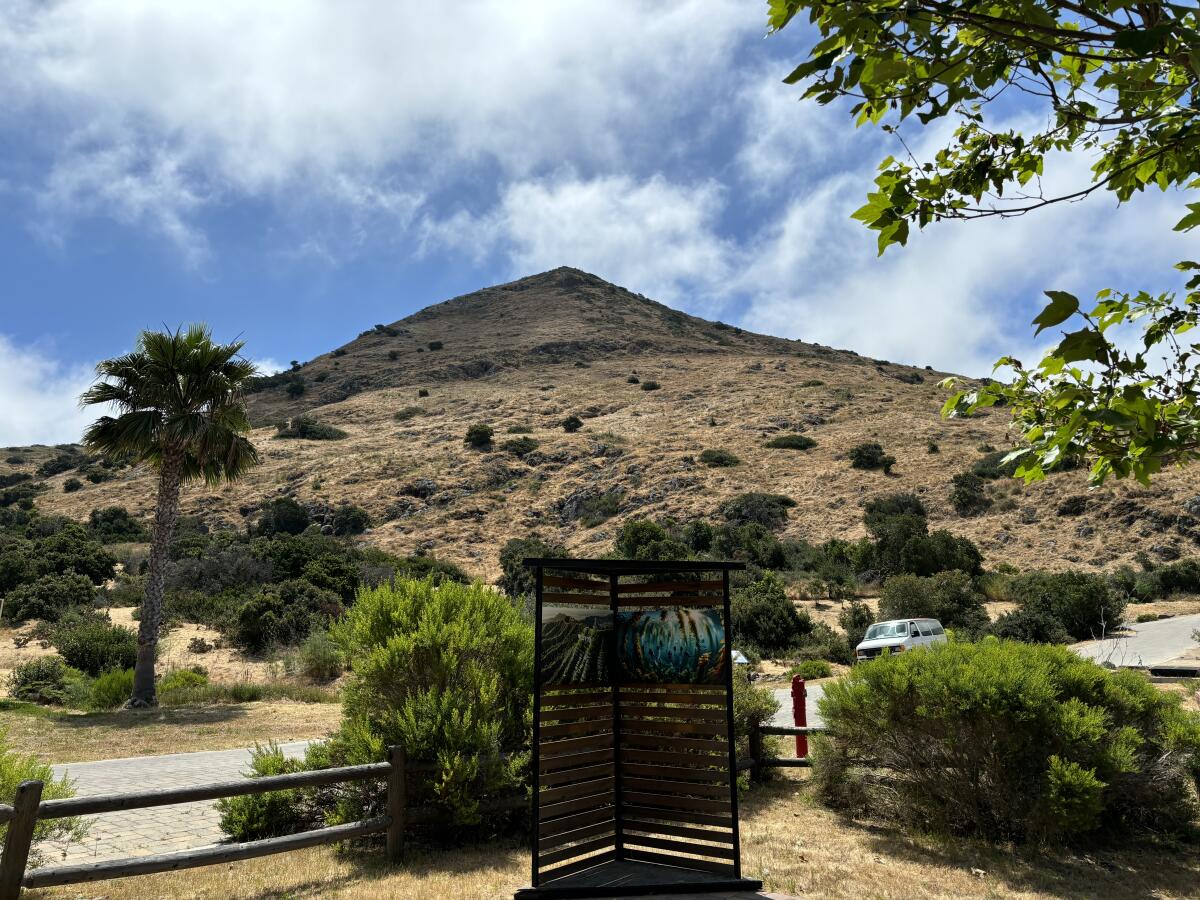
This is the latest edition of Boiling Point, a newsletter about climate change and the environment in the American West. Sign up here to get in your inbox. Or open the newsletter in your web browser here.
For more climate and environment news, follow @Sammy_Roth on X.
Toward a more sustainable California
Get Boiling Point, our newsletter exploring climate change, energy and the environment, and become part of the conversation — and the solution.
You may occasionally receive promotional content from the Los Angeles Times.




